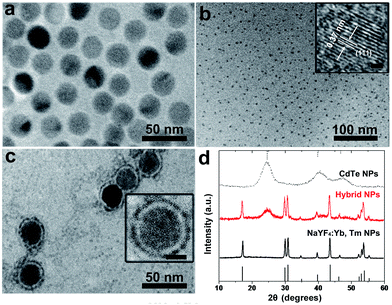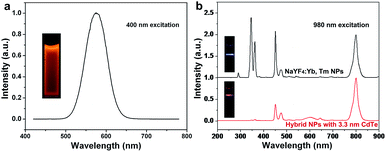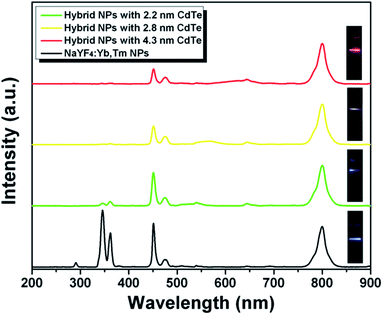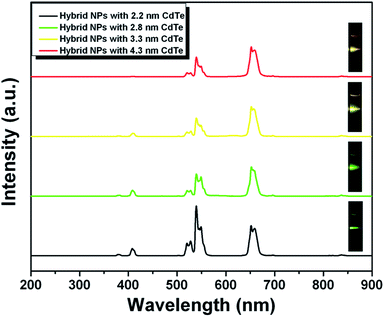A dual-mode luminescent probe composed of co-assembled down-conversion CdTe and up-conversion NaYF4:Yb,Tm(Er) nanoparticles†
Tingting Liab,
Zhennan Wua,
Tingting Huanga,
Jiale Liua,
Li Rongc,
Shijie Lan*c,
Zuoxing Guo*b,
Hao Zhang*a and
Bai Yanga
aState Key Laboratory of Supramolecular Structure and Materials, College of Chemistry, Jilin University, Changchun 130012, P. R. China. E-mail: hao_zhang@jlu.edu.cn
bKey Laboratory of Automobile Materials, Ministry of Education, College of Materials Science and Engineering, Jilin University, Changchun 130022, P. R. China. E-mail: guozx@jlu.edu.cn
cFirst Hospital of Jilin University, Changchun 130021, P. R. China. E-mail: lanshijie@jlu.edu.cn
First published on 7th May 2015
Abstract
Multiplex luminescent probes with good water-dispersibility are basic materials in current biological research as labels and sensors. In this work, we demonstrate a facile approach to fabricate water-dispersible dual-mode luminescent probes by co-assembling down-conversion CdTe nanoparticles (NPs) and up-conversion NaYF4:Yb,Tm(Er) NPs. 3-Mercaptopropionic acid (MPA)-capped CdTe NPs are water soluble, while oleic acid (OA)-capped NaYF4:Yb,Tm(Er) NPs are dispersed in chloroform. There also exists an excess of Cd–MPA complex in the CdTe aqueous solution. After mixing CdTe and NaYF4:Yb,Tm(Er), the MPA on CdTe NPs and Cd–MPA complexes is capable of partially replacing the OA on NaYF4:Yb,Tm(Er) NPs, thus transferring NaYF4:Yb,Tm(Er) NPs to water and forming CdTe–NaYF4:Yb,Tm(Er) hybrid NPs. The hybrid NPs combine the down-conversion emission of CdTe and the up-conversion emission of NaYF4:Yb,Tm(Er), which can be excited both by 400 and 980 nm irradiation and exhibit dual-mode emission. Both Förster resonance energy transfer from NaYF4:Yb,Tm(Er) to CdTe and photon re-absorption are observed as the hybrid NPs are excited by 980 nm irradiation.
1. Introduction
As alternatives to organic dyes and fluorescent proteins, inorganic nanoparticles (NPs) with strong luminescence have been widely applied for biomedical assays, bio-sensing, multi-targeting and diagnosis, because of their high resolution and convenience.1–4 Significant progress is achieved in using down-conversion semiconductor NPs,5 namely the visible emission is generated by absorbing light with a shorter wavelength, usually blue or ultraviolet irradiation. For example, CdSe- and CdTe-based NPs have been popularly exploited in the past two decades, owing to their high photoluminescence quantum yields, narrow emission spectra, broad absorption spectra, as well as size-dependent emission colors.6,7 Water-solubility is another key factor for biological applications.8,9 In this respect, high-quality CdSe NPs that are synthesized in non-polar solvents must be transferred to water either via surface ligand exchange or further encapsulation.10,11 In comparison, the CdTe NPs synthesized in water show better biocompatibility, making them directly applicable in biological research.12However, when the down-conversion NPs are used, the strong tissue absorption, unwished tissue damage, and lack of penetration depth, caused by the excitation light below 600 nm, greatly limit the practical application.13–15 This problem is proposed to be solved by employing up-conversion NPs, namely the visible emission is generated by absorbing the light with longer wavelength, usually near-infrared (NIR) irradiation.16,17 These up-conversion NPs inherently process weak autofluorescence and strong penetration under NIR irradiation, which are more suitable for biological imaging.18–21 In comparison to conventional two-photon excited NPs, which require ultrafast femtosecond lasers, lanthanide-doped NaYF4 NPs can emit up-conversion luminescence by the excitation of low-power continuous wave diode lasers, such as a 980 nm laser, via multi-photon processes.22 In this context, NaYF4 host lattices possess low vibrational energy, a long lifetime of the excited states, and a high radiative emission rate.23 After co-doping of lanthanides, typically Yb3+/Tm3+(Er3+), prominent absorption and the subsequent energy transfer become more favorable.24,25 As a result, NaYF4:Yb,Tm(Er) emitters exhibit a high up-conversion luminescence efficiency, which is not susceptible to the outer environment.26
The integration of down-conversion and up-conversion NPs to fabricate hybrid NPs has been proposed for achieving dual-mode luminescent probes, because such systems offer the tremendous opportunity to create high resolution through convenient approaches.27–30 A possible strategy is the epitaxial growth of down-conversion NPs outside the seeds of up-conversion NPs, or vice versa.31,32 However, the lattice mismatch, cumbersome process, and poor water-dispersibility greatly limit the practice.33 So, most successful examples are based on hybrid and assembly strategies, for instance the hybridization by silica and/or polymer coating, and layer-by-layer co-assembly using polyelectrolytes.26,34 The silica/polymer coating method is successful for producing particles with diameters over 100 nm, but less capable for achieving small particles.35,36 The big size in return lowers the water-dispersibility of the products. Layer-by-layer assembly is a general method for a variety of NPs.37 But luminescence quenching and NP aggregation usually occur during the laborious assembly. Facile and feasible approaches are still welcome for producing dual-mode luminescent probes by integrating down-conversion and up-conversion NPs.
In this paper, we demonstrate a facile approach for fabricating dual-mode luminescent probes from CdTe and NaYF4:Yb,Tm(Er) NPs. The conjugation of different NPs and water-dispersibility are simultaneously achieved by a partial ligand-exchange strategy. In this method, the Cd–mercaptopropionic acid (MPA) complexes, existing both on CdTe NPs and in an aqueous solution of NPs, can partially replace the oleic acid (OA) on hydrophobic NaYF4:Yb,Tm(Er) NPs, which leads to a CdTe-surrounded NaYF4:Yb,Tm(Er) structure. The strong emission of hybrid NPs can be excited both by 400 and 980 nm irradiation. In addition, the NaYF4:Yb,Tm(Er) emission in the blue-green region can be absorbed by CdTe NPs via photon re-absorption. So, 980 nm irradiation also excites the emission of CdTe NPs. The Förster resonance energy transfer (FRET) from NaYF4:Yb,Tm(Er) to CdTe is also revealed by studying luminescence lifetimes, though FRET doesn’t contribute to CdTe emission.
2. Experimental
2.1 Materials
Oleic acid (OA, technical grade, 90%), yttrium chloride hexahydrate (YCl3·6H2O, 99.9%), ytterbium chloride hexahydrate (YbCl3·6H2O, 99.9%), erbium chloride hexahydrate (ErCl3·6H2O, 99.9%), thulium chloride hexahydrate (TmCl3·6H2O, 99.9%), tellurium powder (−200 mesh, 99.8%), and 3-mercaptopropionic acid (MPA, 99+%), were purchased from Aldrich. Sodium hydroxide (NaOH 99%), ammonium fluoride (NH4F), NaBH4 (96%), CdCl2 (99%), ethanol, methanol, and liquid paraffin were all commercially available products and used as received without further purification.2.2 Preparation of OA-capped NaYF4:Yb,Tm(Er) up-conversion NPs and MPA-capped CdTe down-conversion NPs
OA-capped NaYF4:Yb,Tm(Er) up-conversion NPs were synthesized in liquid paraffin according to our previous method.38 The Y/Yb/Tm(Er) molar ratio was 80/19.5/0.5. The as-prepared NaYF4:Yb,Tm(Er) NPs were precipitated from paraffin solution through the addition of ethanol and washed with ethanol–chloroform (1![[thin space (1/6-em)]](https://www.rsc.org/images/entities/char_2009.gif) :
:![[thin space (1/6-em)]](https://www.rsc.org/images/entities/char_2009.gif) 1 v/v) for three times at room temperature. The precipitates were collected without any size-selection process and re-dispersed in chloroform with the concentration of 3 mg mL−1.
1 v/v) for three times at room temperature. The precipitates were collected without any size-selection process and re-dispersed in chloroform with the concentration of 3 mg mL−1.
MPA-capped CdTe NPs with different emission colours were synthesized in water according to our previous method.39 In brief, aqueous CdTe precursors were foremost prepared by injecting freshly prepared NaHTe solution into N2-saturated CdCl2 solution at pH 9.5 in the presence of MPA. The precursor concentration was 1.25 mmol L−1 referring to the concentration of Cd2+, whereas the molar ratio of Cd2+/MPA/HTe2− was 1/2/0.2. Subsequently, the precursors were refluxed at 100 °C for a specific duration to obtain the NPs with desired sizes and emission colours. After preparation, 2-propanol was added into the NP solution until the solution became slightly turbid. The mixture was centrifuged at 6000 rpm for 3 min. After decantation of the supernatant, the precipitates were collected and re-dispersed in water. The products were treated by repeated water washing and centrifugation for three times. Then the CdTe NPs were re-dispersed in water with the concentration of 10 mmol L−1 referring to the concentration of Cd.
2.3 Preparation of aqueous CdTe–NaYF4:Yb,Tm(Er) hybrid NPs
A typical procedure for fabricating CdTe–NaYF4:Yb,Tm hybrid NPs is described as follows: 2 mL 3 mg mL−1 OA-capped NaYF4:Yb,Tm NP chloroform solution was mixed with 12 mL 10 mmol L−1 MPA-capped CdTe NP aqueous solution under stirring. The diameter of CdTe NPs was 3.3 nm. The NP mixture was kept stirring for 72 h in the dark at room temperature. Then, the mixture was transferred into a separatory funnel. The aqueous phase was separated to obtain hybrid NPs. Following a similar process, except using other sized CdTe NPs (2.2, 2.8, and 4.3 nm) rather than 3.3 nm CdTe, a variety of CdTe–NaYF4:Yb,Tm hybrid NPs were fabricated. Instead of NaYF4:Yb,Tm, NaYF4:Yb,Er NPs were also used to fabricate hybrid NPs, which produced CdTe–NaYF4:Yb,Er hybrid NPs.2.4 Characterization
UV-visible absorption spectra were obtained using a Shimadzu 3100 UV-vis spectrophotometer. Fluorescence spectroscopy was performed using a Shimadzu RF-5301 PC spectrophotometer. The excitation wavelength was 400 nm. All optical measurements were performed at room temperature under ambient conditions. Transmission electron microscopy (TEM) was conducted using a Hitachi H-800 electron microscope at an acceleration voltage of 200 kV with a CCD camera. High-resolution TEM (HRTEM) was implemented using a JEM-2100F electron microscope at 200 kV. The X-ray powder diffraction (XRD) investigation was carried out using a Rigaku X-ray diffractometer using Cu K radiation (λ = 1.5418 Å). Up-conversion fluorescence spectra were recorded using a Hitachi F-4500 fluorescence spectrophotometer with a 980 nm laser at room temperature. FTIR spectra were recorded using a Nicolet AVATAR 360 FTIR instrument. Optical photos were collected using a Canon IXUS 204HS digital camera under 980 nm laser and UV excitation. The luminescence dynamics were investigated using a laser-system consisting of a Nd:YAG pumping laser (1064 nm), a third-order harmonic generator (355 nm), and a tunable optical parameter oscillator (OPO, Continuum Precision II 8000). The pulse duration, repetition frequency, and line width were 10 ns, 10 Hz, and 4–7 cm−1, respectively.3. Results and discussion
The procedure for fabricating CdTe–NaYF4:Yb,Tm(Er) hybrid NPs is illustrated in Scheme 1. The co-assembling process is very simple. Just by stirring the mixture of CdTe NP aqueous solution and NaYF4:Yb,Tm(Er) NP chloroform solution in the dark at room temperature for 72 h, hybrid NPs with good water-dispersibility are obtained. In this method, aqueous CdTe NPs are capped by MPA. The mercapto-group of MPA links with CdTe through Cd–S bonding, while the remaining carboxylic groups make the NPs dispersible in water.40 In addition, there also exists an excess of Cd–MPA complex in the NP solution, resulting from the synthesis method of aqueous CdTe NPs.41 The NaYF4:Yb,Tm(Er) NPs are capped by OA. The long alkyl chain of OA makes NaYF4:Yb,Tm(Er) dispersible in chloroform rather than in water. Under stirring, the OA on NaYF4:Yb,Tm(Er) NPs can be replaced by the Cd–MPA complexes or CdTe NPs in the aqueous phase through carboxyl-exchange.42 Because the density of carboxyls on the Cd–MPA complexes is higher than those on the CdTe NPs, the carboxyl-exchange should mainly occur between the NaYF4:Yb,Tm(Er) NPs and the Cd–MPA complexes. The Cd–MPA complexes can further bond with CdTe NPs through the coordinative interaction between the MPA on the NP surface and the Cd of Cd–MPA complexes, which has been proved by our previous study.39 Since the amount of CdTe NPs is much higher than NaYF4:Yb,Tm(Er) NPs in the mixture, hybrid NPs with a CdTe-surrounded NaYF4:Yb,Tm(Er) structure are produced (Scheme 1). As a result, the resulting hybrid NPs are well dispersed in water.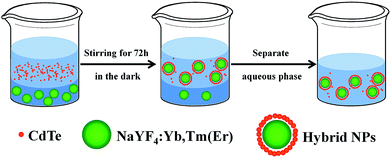 | ||
| Scheme 1 Schematic illustration of the formation of CdTe–NaYF4:Yb,Tm(Er) hybrid NPs on the basis of carboxyl-exchange, which produces CdTe-surrounded NaYF4:Yb,Tm(Er) NPs. | ||
Fig. 1a presents the TEM image of original NaYF4:Yb,Tm NPs that are dispersed in chloroform, which appear quasi-spherical in shape with an average diameter of 20 nm. The corresponding up-conversion emission spectrum is shown in Fig. S1.† A blue emission is observed when irradiated by a 980 nm laser (Fig. S1† inset). Fig. 1b exhibits the TEM image of the CdTe NPs used for transferring the NaYF4:Yb,Tm NPs. The average diameter is 3.3 nm. The photoluminescence (PL) spectrum of the CdTe NPs exhibits an emission peak at 578 nm, which corresponds to an orange color (Fig. S2†). The TEM images of the as-prepared hybrid NPs are presented in Fig. 1c and S3.† By comparing with the TEM images of original NaYF4:Yb,Tm and CdTe NPs, the CdTe-surrounded NaYF4:Yb,Tm structure is confirmed. Note that a cyclic structure with light contrast around NaYF4:Yb,Tm is found for each hybrid NP (Fig. 1c). The thickness of the circle is about 3.0 nm, consistent with the length of the OA alkyl chain. This means that OA is partially exchanged by MPA carboxyl, whereas most of the OA remains on the NaYF4:Yb,Tm NPs. This consideration is proved by comparing the FTIR spectra of the original NaYF4:Yb,Tm NPs and the resulting hybrid NPs (Fig. S4†). For the original NaYF4:Yb,Tm NPs, the peaks at 1565 and 1418 cm−1 are assigned to the –COO− group of OA, while the peaks at 2921 and 2852 cm−1 are assigned to the C–H vibration of the OA alkyl chain. After forming hybrid NPs, no significant change in the FTIR spectra is observed. This means that the surface ligand of the NaYF4:Yb,Tm NPs is less changed. The coexistence of NaYF4:Yb,Tm and CdTe NPs is further confirmed by XRD characterization (Fig. 1d). The XRD pattern of hybrid NPs exhibits the lattice parameters of both β-NaYF4 and cubic CdTe,43,44 which agrees well with the parameters of the original NPs.
The formation of the CdTe-surrounded NaYF4:Yb,Tm(Er) structure is attributed to the phase transfer process and the large difference in CdTe and NaYF4 size. In the phase transfer from organic to aqueous media, the surface energy of NaYF4 NPs is high in water. The adsorption of CdTe NPs is capable of lowering the surface energy of NaYF4 NPs, thus avoiding NaYF4 aggregation.45 Moreover, the size of CdTe NPs is much smaller than NaYF4 NPs. So, CdTe NPs adsorb on NaYF4 rather than in reverse. The aforementioned mechanism is further confirmed by control experiments (Fig. S5†). For example, the excess of Cd–MPA complex is removed before fabrication, which fails to produce NaYF4–CdTe hybrid NPs (Fig. S5a†). In addition, the concentration of CdTe NPs is decreased to 1/10, which also doesn’t produce NaYF4–CdTe hybrid NPs (Fig. S5b†). As mentioned above, an excess of Cd–MPA complexes and CdTe NPs is crucial for producing hybrid NPs via carboxyl-exchange. Decreased amounts of Cd–MPA complexes and CdTe NPs reasonably lead to insufficient carboxyl-exchange, thus failing to obtain CdTe-surrounded NaYF4:Yb,Tm(Er) hybrids. Also, CdTe coating results in a hydrophilic surface of hybrid NPs, and hence the water-dispersibility. The hybrid NPs remain stable in the water with storing in the dark for 2 months.
With respect to the emission property, the down-conversion emission of CdTe–NaYF4:Yb,Tm hybrid NPs upon 400 nm excitation is completely similar to that of the composed CdTe NPs, namely the orange emission of 3.3 nm CdTe (Fig. 2a and S2†). However, upon 980 nm excitation, the hybrid NPs exhibit a noticeable change of the up-conversion emission spectrum in comparison with the original NaYF4:Yb,Tm NPs (Fig. 2b). The apparent emission color also alters from blue to red. To clearly show the spectral variation, the emission intensity is normalized at 800 nm and compared. For hybrid NPs, the peak intensities at 350 and 478 nm decrease, while a new peak at 600 nm appears. By analyzing the feature of the 600 nm emission, the peak can be assigned to the orange emission of 3.3 nm CdTe. Note that CdTe is a down-conversion material, which can not be excited by a 980 nm laser directly. Consequently, such emission should be from photon re-absorption and/or FRET between NaYF4:Yb,Tm and CdTe. As for photon re-absorption, CdTe possesses a broad absorption spectrum. The 3.3 nm CdTe NPs also absorb the blue emission of NaYF4:Yb,Tm as irradiated by a 980 nm laser. Namely, NaYF4:Yb,Tm acts as the donor, while CdTe acts as the acceptor. In addition, the distance between co-assembled CdTe and NaYF4:Yb,Tm NPs is 3 nm (Fig. 1c), meeting the condition of FRET.46,47 However, FRET doesn’t seem to contribute to the CdTe emission, because FRET is a non-radiative process. To confirm the existence of FRET between NaYF4:Yb,Tm and CdTe we further studied their luminescence decay curves (Fig. 3). Usually, the decrease of average lifetime of donor emission is crucial evidence of FRET.48 As shown in Fig. 3a and b, the presence of acceptor CdTe NPs leads to the decrease of the average lifetime of NaYF4:Yb,Tm at 478 nm from 278.5 to 217.5 μs under the excitation at 980 nm. The average lifetime at 800 nm also decreases from 340 to 265 μs (Fig. 3c and d). In NaYF4:Yb,Tm, the up-conversion emission is mainly from excited Tm3+ (Fig. 4).49 So, the decreased average lifetimes reveal the partial transfer of excited photons from Tm3+ to the acceptor. It is CdTe in the current system. Such a transfer is more significant at 800 nm than 478 nm. Note that the variation of lifetimes is mainly from FRET rather than phase transfer. The presence of the CdTe acceptor leads to a 22% decrease of the average Tm luminescence lifetime recorded at 478 and 800 nm. In comparison, a 4% lifetime decrease is observed for the up-conversion NPs transferring from organic to aqueous media in the absence of CdTe.42 Thus, the aforementioned results confirm the occurrence of FRET between co-assembled CdTe and NaYF4:Yb,Tm NPs; despite this, FRET doesn’t contribute to the CdTe emission.
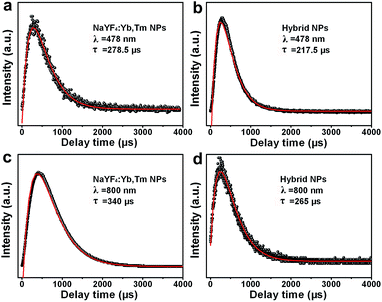 | ||
| Fig. 3 Luminescence decay curves of the NaYF4:Yb,Tm NPs (a and c) and hybrid NPs (b and d) that are detected at 478 nm (a and b) and 800 nm (c and d). | ||
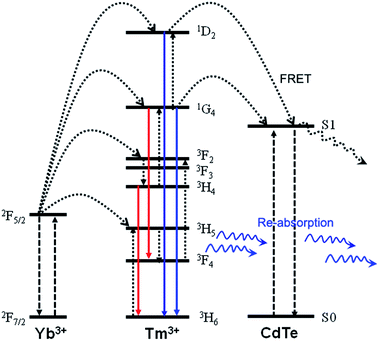 | ||
| Fig. 4 Schematic illustration of the energy transfer in hybrid NPs from NaYF4:Yb,Tm to CdTe upon 980 nm laser irradiation. | ||
On the basis of these results, it is convincing that both photon re-absorption and FRET between NaYF4:Yb,Tm and CdTe is present in CdTe–NaYF4:Yb,Tm hybrid NPs. However, the FRET from NaYF4:Yb,Tm to CdTe only weakens the NaYF4:Yb,Tm emission at specific wavelengths, while CdTe NPs are excited mainly via photon re-absorption. The schematic energy transfer is shown in Fig. 4. Upon 980 nm excitation, the 2F7/2 → 2F5/2 transition of Yb3+, which is the sensitizer, is of equal resonance with the up-converting lanthanide ion of Tm3+. So, the 1D2 level in Tm3+ is populated through the efficient energy transfer from Yb3+. The 1D2, 1G4, 3F2, and 3H5 levels can accept the relax non-radiative energy, and then generate 1D2 → 3H6 (∼362 nm), 1G4 → 3H6 (∼478 nm), and 3H4 → 3H6 (∼800 nm) transitions.50 As a result, blue and red emissions are observed. Because the blue emission overlaps the absorption spectrum of 3.3 nm CdTe NPs, the emitted photons from the transition of 1D2 → 3H6 (∼362 nm) can be re-absorbed by the conduction band of CdTe. The further exciton transitions from the CdTe conduction band to the valence band generate the observed CdTe emission.
The aforementioned results imply that the match of energy level is crucial for dual-mode luminescent probes with photon re-absorption behavior. To confirm this, the CdTe NPs with different sizes and subsequent emission colors were assembled with NaYF4:Yb,Tm NPs to fabricate hybrid NPs (Fig. 5 and S6†). It is known that CdTe NPs possess size-dependent emission with less excitation dependence.51 For example, the CdTe NPs with the diameters of 2.2, 2.8, 3.3, and 4.3 nm, can be excited by 400 nm irradiation, and emit green, yellow, orange, and red emissions, respectively. The absorption and emission spectra of 2.2, 2.8, and 4.3 nm CdTe NPs are shown in Fig. S7.† Due to the small size of 2.2 and 2.8 nm NPs, their absorption does not fully match with the emission of NaYF4:Yb,Tm upon 980 nm excitation. Namely, the donor and accepter do not match to generate photon re-absorption. Consequently, the hybrid NPs do not exhibit the emission properties of CdTe NPs (Fig. 5). In addition, 4.3 nm CdTe NPs also emit a red emission, which overlaps with the NaYF4:Yb,Tm red emission. So, no separate emission peak of 4.3 nm CdTe NPs is observed for the corresponding hybrid NPs.
On the other hand, the energy donor is also important for generating photon re-absorption. Fig. S8† indicates the up-converting emission of NaYF4:Yb,Er NPs, which exhibit green emission. After co-assembling with differently sized CdTe NPs and excited by a 980 nm laser, the apparent emission color changes from green to yellow (Fig. 6). By normalizing the emission peak at 650 nm, a clear increase of the red-to-green intensity ratio is observed. NaYF4:Yb,Er possesses four emission peaks at 408, 520, 539, and 650 nm (Fig. S8†). In comparison with NaYF4:Yb,Tm, these emissions do not match the absorption of CdTe. So, it is difficult to generate photon re-absorption and separate CdTe emission. Nevertheless, the big CdTe NPs still absorb the NaYF4:Yb,Er emissions at 520 and 539 nm, thus altering the red-to-green emission ratio.
4. Conclusions
In summary, we have demonstrated the co-assembly of hydrophilic CdTe NPs and hydrophobic NaYF4:Yb,Tm(Er) NPs through a ligand-exchange strategy, which produces water-dispersible dual-mode luminescent probes with both down-conversion and up-conversion behavior. MPA-capped CdTe NPs are water soluble, while OA-capped NaYF4:Yb,Tm(Er) NPs are dispersed in chloroform. There also exists an excess of Cd–MPA complex in the CdTe aqueous solution. The MPA on CdTe NPs and Cd–MPA complexes partially replaces the OA on NaYF4:Yb,Tm(Er), thus transferring the NaYF4:Yb,Tm(Er) NPs to the water by forming a CdTe-surrounded NaYF4:Yb,Tm(Er) structure. The resulting hybrid NPs exhibit controllable up-conversion emission from blue to red upon 980 nm laser irradiation, and green to red down-conversion emission upon 400 nm excitation. What is more, the inherent photochemical stability of inorganic NPs and in particular the high signal-to-noise ratio of dual-mode luminescent probes make CdTe–NaYF4:Yb,Tm(Er) hybrid NPs competitive candidates for neuroimaging, tumor cell labeling, and other biological applications.Acknowledgements
This work was supported by NSFC (51425303, 81301650, 21374042, 21174051, and 21221063), the 973 Program of China (2014CB643503), Natural Science Foundation of Jilin Province (20140101048JC), the Special Project from MOST of China, and the Fundamental Research Funds for the Central Universities.Notes and references
- Y. Wang, Z. Tang and N. A. Kotov, Nano Today, 2005, 8, 20–31 Search PubMed.
- A. Louie, Chem. Rev., 2010, 110, 3146–3195 CrossRef CAS PubMed.
- J. Yao, M. Yang and Y. Duan, Chem. Rev., 2014, 114, 6130–6178 CrossRef CAS PubMed.
- H. Jiang and X. Wang, Anal. Chem., 2014, 86, 6872–6878 CrossRef CAS PubMed.
- C. Gerhards, C. Schulz-Drost, V. Sgobba and D. M. Guldi, J. Phys. Chem. B, 2008, 112, 14482–14491 CrossRef CAS PubMed.
- A. P. Alivisatos, Science, 1996, 271, 933–937 CAS.
- A. Shavel, N. Gaponik and A. Eychmüller, J. Phys. Chem. B, 2006, 110, 19280–19284 CrossRef CAS PubMed.
- T. Wang and X. Jiang, ACS Appl. Mater. Interfaces, 2013, 5, 1190–1196 CAS.
- Q. Wang, Y. Kuo, Y. Wang, G. Shin, C. Ruengruglikit and Q. Huang, J. Phys. Chem. B, 2006, 110, 16860–16866 CrossRef CAS PubMed.
- R. Gill, M. Zayats and I. Willner, Angew. Chem., Int. Ed., 2008, 47, 7602–7625 CrossRef CAS PubMed.
- Q. Mu, G. Jiang, L. Chen, H. Zhou, D. Fourches, A. Tropsha and B. Yan, Chem. Rev., 2014, 114, 7740–7781 CrossRef CAS PubMed.
- H. Zhang, L. Wang, H. Xiong, L. Hu, B. Yang and W. Li, Adv. Mater., 2003, 15, 1712–1715 CrossRef CAS PubMed.
- Y. Zhang, L. Zhang, R. Deng, J. Tian, Y. Zong, D. Jin and X. Liu, J. Am. Chem. Soc., 2014, 136, 4893–4896 CrossRef CAS PubMed.
- C. Wang, L. Cheng and Z. Liu, Theranostics, 2013, 3, 317–330 CrossRef PubMed.
- L. Cheng, C. Wang and Z. Liu, Nanoscale, 2013, 5, 23–37 RSC.
- M. Haase and H. Schäfer, Angew. Chem., Int. Ed., 2011, 50, 5808–5829 CrossRef CAS PubMed.
- L. H. Fischer, G. S. Harms and O. S. Wolfbeis, Angew. Chem., Int. Ed., 2011, 50, 4546–4551 CrossRef CAS PubMed.
- D. Yang, X. Kang, P. Ma, Y. Dai, Z. Hou, Z. Cheng, C. Li and J. Lin, Biomaterials, 2013, 34, 1601–1612 CrossRef CAS PubMed.
- B. Chen, B. Dong, J. Wang, S. Zhang, L. Xu, W. Yu and H. Song, Nanoscale, 2013, 5, 8541–8549 RSC.
- L. Cheng, C. Wang, X. Ma, Q. Wang, Y. Cheng, H. Wang, Y. Li and Z. Liu, Adv. Funct. Mater., 2013, 23, 272–280 CrossRef CAS PubMed.
- Q. Liu, Y. Sun, T. Yang, W. Feng, C. Li and F. Li, J. Am. Chem. Soc., 2011, 133, 17122–17125 CrossRef CAS PubMed.
- H. Schäfer, P. Ptacek, K. Kömpe and M. Haase, Chem. Mater., 2007, 19, 1396–1400 CrossRef.
- S. Han, R. Deng, X. Xie and X. Liu, Angew. Chem., Int. Ed., 2014, 53, 11702–11715 CrossRef CAS PubMed.
- D. K. Chatterjee, M. K. Gnanasammandhan and Y. Zhang, Small, 2010, 6, 2781–2795 CrossRef CAS PubMed.
- F. Zhang, R. Che, X. Li, C. Yao, J. Yang, D. Shen, P. Hu, W. Li and D. Zhao, Nano Lett., 2012, 12, 2852–2858 CrossRef CAS PubMed.
- F. Wang and X. Liu, Chem. Soc. Rev., 2009, 38, 976–989 RSC.
- Q. Dou, N. M. Idris and Y. Zhang, Biomaterials, 2013, 34, 1722–1731 CrossRef CAS PubMed.
- R. Wang, X. Li, L. Zhou and F. Zhang, Angew. Chem., Int. Ed., 2014, 53, 12086–12090 CrossRef CAS PubMed.
- Y. Dai, P. Ma, Z. Cheng, X. Kang, X. Zhang, A. Hou, C. Li, D. Yang, X. Zhai and J. Lin, ACS Nano, 2012, 6, 3327–3338 CrossRef CAS PubMed.
- A. Bednarkiewicz, M. Nyk, M. Samoc and W. Strek, J. Phys. Chem. C, 2010, 114, 17535–17541 CAS.
- Y. Liu, D. Tu, H. Zhu, R. Li, W. Luo and X. Chen, Adv. Mater., 2010, 22, 3266–3271 CrossRef CAS PubMed.
- C. Yan, A. Dadvand, F. Rosei and D. F. Perepichka, J. Am. Chem. Soc., 2010, 132, 8868–8869 CrossRef CAS PubMed.
- J. Chang, Y. Liu, J. Li, S. Wu, W. Niu and S. Zhang, J. Mater. Chem. C, 2013, 1, 1168–1173 RSC.
- P. Li, Q. Peng and Y. Li, Adv. Mater., 2009, 21, 1945–1948 CrossRef CAS PubMed.
- M. An, J. Cui, Q. He and L. Wang, J. Mater. Chem. B, 2013, 1, 1333–1339 RSC.
- P. Kumar, J. Dwivedi and B. K. Gupta, J. Mater. Chem. C, 2014, 2, 10468–10475 RSC.
- C. Li, F. Wang, J. Zhu and J. C. Yu, Appl. Catal., B, 2010, 100, 433–439 CrossRef CAS PubMed.
- Z. Wu, C. Guo, S. Liang, H. Zhang, L. Wang, H. Sun and B. Yang, J. Mater. Chem., 2012, 22, 18596–18602 RSC.
- H. Zhang, Z. Zhou and B. Yang, J. Phys. Chem. B, 2003, 107, 8–13 CrossRef CAS.
- J. Han, X. Luo, D. Zhou, H. Sun, H. Zhang and B. Yang, J. Phys. Chem. C, 2010, 114, 6418–6425 CAS.
- D. Zhou, M. Lin, Z. Chen, H. Sun, H. Zhang, H. Sun and B. Yang, Chem. Mater., 2011, 23, 4857–4862 CrossRef CAS.
- D. Li, B. Dong, X. Bai, Y. Wang and H. Song, J. Phys. Chem. C, 2010, 114, 8219–8226 CAS.
- D. Zhou, J. Han, Y. Liu, M. Liu, X. Zhang, H. Zhang and B. Yang, J. Phys. Chem. C, 2010, 114, 22487–22492 CAS.
- J. Liu, Y. Liu, Q. Liu, C. Li, L. Sun and F. Li, J. Am. Chem. Soc., 2011, 133, 15276–15279 CrossRef CAS PubMed.
- S. Mann, Nat. Mater., 2009, 8, 781–792 CrossRef CAS PubMed.
- C. Zhang, Y. Yuan, S. Zhang, Y. Wang and Z. Liu, Angew. Chem., Int. Ed., 2011, 50, 6851–6854 CrossRef CAS PubMed.
- A. R. Clapp, I. L. Medintz, J. M. Mauro, B. R. Fisher, M. G. Bawendi and H. Mattoussi, J. Am. Chem. Soc., 2004, 126, 301–310 CrossRef CAS PubMed.
- W. R. Algar, D. Wegner, A. L. Huston, J. B. Blanco-Canosa, M. H. Stewart, A. Armstrong, P. E. Dawson, N. Hildebrandt and I. L. Medintz, J. Am. Chem. Soc., 2012, 134, 1876–1891 CrossRef CAS PubMed.
- J. C. Boyer, L. A. Cuccia and J. A. Capobianco, Nano Lett., 2007, 7, 847–852 CrossRef CAS PubMed.
- Y. Zhu, S. Cui, X. Chen, W. Xu, P. Zhou, Y. Wang, L. Xu, H. Song, L. Huang and W. Huang, Nanoscale, 2014, 6, 8075–8083 RSC.
- D. Zhou, M. Liu, M. Lin, X. Bu, X. Luo, H. Zhang and B. Yang, ACS Nano, 2014, 8, 10569–10581 CrossRef CAS PubMed.
Footnote |
| † Electronic supplementary information (ESI) available: TEM and HRTEM images, and absorption, emission, and FTIR spectra of CdTe, NaYF4:Yb,Tm(Er) and the hybrid NPs. See DOI: 10.1039/c5ra07964k |
| This journal is © The Royal Society of Chemistry 2015 |

